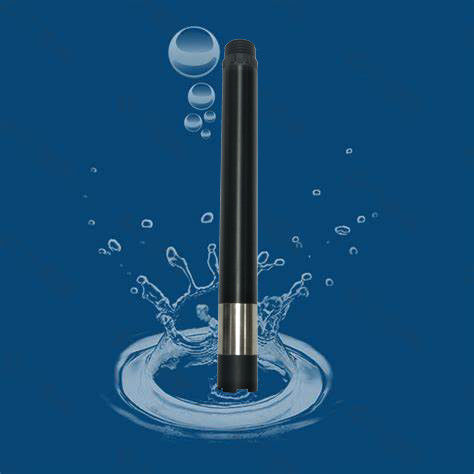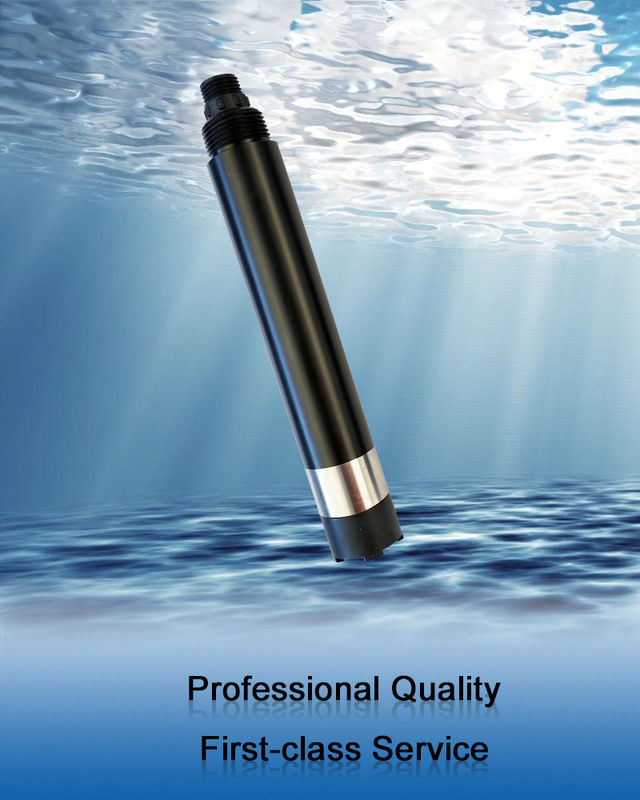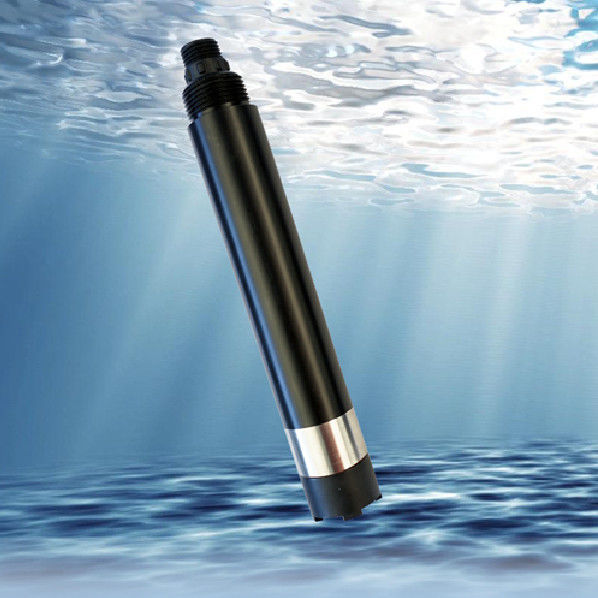KFDO310 integrated on-line fluorescence dissolved oxygen sensor is designed and made based on the quenching principle of excited fluorescence of specific substances in physics. The blue light from the light-emitting diode illuminates the fluorescent material on the inner surface of the fluorescent cap. The fluorescent material on the inner surface is excited and emits red light. By detecting the phase difference between the red light and the blue light, and comparing it with the internal calibration value, the concentration of oxygen molecule can be calculated, and the final value can be output by temperature automatic compensation.

No electrolytes, no polarization
No need to consume oxygen, not affected by the flow rate
Built-in temperature sensor, automatic temperature compensation
Free from chemicals like sulfides
Small drift, fast response, more accurate measurement
Maintenance-free, long service life, lower use cost
Fluorescent caps are easy to replace
RS-485 interface, Modbus-RTU protocol
| Model number |
KFDO310 |
| Measuring principle |
fluorescence |
| Range |
0ー20 mg/L (0ー200% saturation, 25 °C) |
| Resolution |
0.01 mg/l, 0.1 °C |
| Precision |
± 2% f.s. , ± 0.5 °C |
| Temperature compensation |
Automatic temperature compensation (PT1000) |
| Output mode |
RS-485 bus, Modbus-RTU protocol |
| Working conditions |
0ー45 °C, < 0.2 mpa |
| Storage temperature |
- 5 ~ 65 °C |
| Installation mode |
Immersion mounting |
| Cable length |
5 meters, other length can be customized |
| Power consumption |
< 0.05 W |
| Power supply |
12 ~ 24 VDC ± 10% |
| Protection level |
IP68 |
| Calibration |
Two-point calibration |
| Fluorescent cap life |
Guaranteed Use for one year (under normal use) |
| Material for sensor housing |
Pom and 316L stainless steel |


The temperature sensing part should be immersed below the liquid surface to avoid collision with the film head surface. The head part of the membrane should be free from sediment.
The cable is a 4-core twisted pair shielded wire defined in line sequence:
Red wire -- power cord (12V-24VDC)
Black line (GND)
Blue Line -- 485a
White line -- 485b
Before electrification, the wiring sequence should be carefully checked to avoid unnecessary losses caused by wiring errors.
Wiring instructions: Consider the cable long-term immersion in water (including seawater) or exposed to air, all wiring is required to do waterproof treatment, customer cable should have a certain anti-corrosion ability.
Maintenance Schedule
Unlike do probes, which are electrochemical in principle, do probes do not consume oxygen and do not need to be cleaned frequently (except when used in viscous liquids).
| Maintenance task |
Recommended maintenance frequency |
| Cleaning sensor |
Wash every 30 days |
| Check the sensor and fluorescent cap for damage |
Check every 30 days |
| Replace fluorescent cap |
It’s changed every year |
| Calibration of sensors (if required by competent authority) |
According to the maintenance schedule required by the competent authority |
Note: the maintenance frequency in the above table is only recommended, ask the maintenance personnel to clean the sensor according to the actual use of the sensor; however, the fluorescent cap replacement frequency is recommended once a year.
Maintenance Method
Sensor outer surface: clean the sensor outer surface with tap water, if there is still debris residue, wipe with a damp soft cloth, for some stubborn dirt, you can add some household cleaning liquid in tap water to clean.
The outer surface of the fluorescent cap: remove the protective cover of the front end of the sensor, rinse the dirt on the light window of the sensor with clean water, and finally cover the cover; if you need to wipe, use a soft cloth and be careful of the force and direction; if you scratch the fluorescent film layer, the sensors won’t work properly.
The inside surface of the fluorescent cap: if water vapor or dust gets into the inside of the fluorescent cap, the cleaning procedure is as follows:
Remove the fluorescent cap;
Flush the inner surface of the fluorescent cap with tap water;
For the grease and oil-containing dirt, with the addition of domestic washing warm water cleaning liquid;
Rinsing the inner surface of the fluorescent cap with deionized water;
Gently dry all surfaces with a clean, non-flannelette cloth and place in a dry place to allow the water to evaporate completely.
Check the wire of the sensor: the wire should not be taut when working normally, otherwise it is easy to break the wire inside the wire and cause the sensor can not work normally.
Inspect the sensor housing for corrosion or other damage.
Day-to-day storage of fluorescent caps: when not in use, put them in a protective cover with a damp sponge, so that the sensor can stay wet for a long time. If the head of the sensor fluorescent cap is dry for a long time, the measurement result will drift and need to be immersed in water for 48 hours before using.
| Mistakes |
Probable cause |
Solution |
|
The interface doesn’t work
Connect or do not display measurement results
|
The controller failed to connect to the cable |
Reconnect the controller to the cable |
| Cable failure |
Please contact us |
| Fluorescent cap unscrewed or damaged |
Reinstall and tighten fluorescent cap or replace fluorescent cap |
| Measurement value is too high, too low or value continues to be unstable |
The outer surface of the fluorescent cap is attached to an object |
Clean the outer surface of the fluorescent cap and agitate the probe during measurement |
| The bioluminescent cap was damaged |
Replace fluorescent cap |
| The fluorescent cap has exceeded its service life |
| The temperature measurement value is out of the measurable range or the reading is out of order |
The temperature sensor is attached to something |
Use a soft brush to gently remove the attachment |
Zero Calibration
Take 2 g sodium sulfite with a balance, measure out 98 mL of water with a 250 mL cylinder, pour the water into a beaker, add the sodium sulfite, stir with a glass rod, dissolve to get 2% sodium sulfite solution, and place the sensor in the solution, zero calibration after 3 minutes of numerical stabilization. Instruction Reference Appendix.
Slope Calibration
The sensor probe is placed in air-saturated water and the slope is calibrated after 3 minutes or so of numerical stabilization. Instruction Reference Appendix.
Preparation of air-saturated water: a 2/3 volume of fresh distilled water is added to a constant temperature water bath to float a porous plastic sheet on the water surface (see figure below) . At the same time with the bubbler (air pump) to the water continuous aeration more than 1 hour, stop aeration, static about 20 minutes after the air saturated water. The sensor is placed in water and the slope is calibrated after the data is stable.

Note: as an alternative, slope calibration can also be performed in water-saturated air. Place the sensor in a calibration bottle with a small amount of water (probe 2-3 mm above water level) to ensure that the sensor cap remains moist but without water droplets, and calibrate the slope after 3 minutes of numerical stabilization.
Avoid exposing the inner surface of the fluorescent cap to sunlight
Please do not touch the fluorescent film with your hands
The surface of fluorescent film is free from air bubble during measurement and calibration
Avoid applying any mechanical stress (pressure, scratches, etc.) directly to the fluorescent film during use
Quality inspection departments have standardized inspection procedures, with advanced and perfect testing equipment and means, and in strict accordance with the rules of inspection, 72-hour aging of products to do experiments, stability experiments, do not let a unqualified product factory.
The consignee will return the lot of the product with 2% nonconformity rate, and all the cost will be borne by the supplier. The standard of consideration refers to the product description provided by the supplier.
Guarantee the quantity and speed of delivery.
This product includes:
1 sensor
1 copy of instruction manual
Certificate 1
Our company provides after-sale service for one year from the date of sale, but does not include damage caused by improper use. If repair or adjustment is needed, please return it at your own expense, the company will repair the damage of the instrument free of charge.

 Your message must be between 20-3,000 characters!
Your message must be between 20-3,000 characters! Please check your E-mail!
Please check your E-mail!  Your message must be between 20-3,000 characters!
Your message must be between 20-3,000 characters! Please check your E-mail!
Please check your E-mail! 



